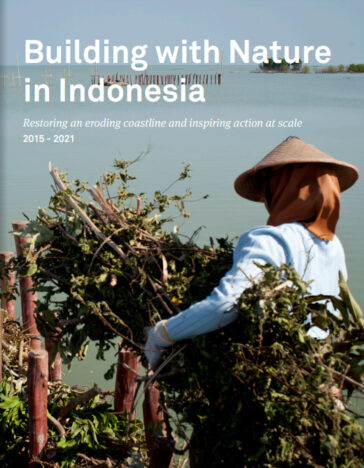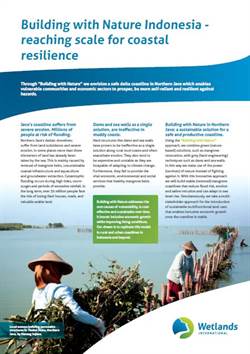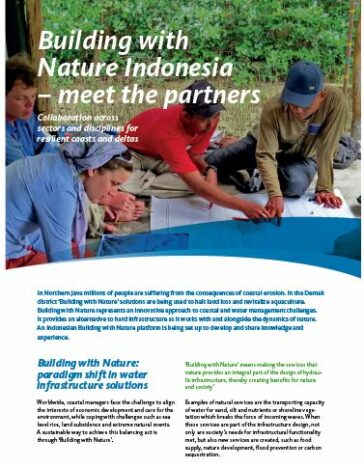Building with Nature Indonesia
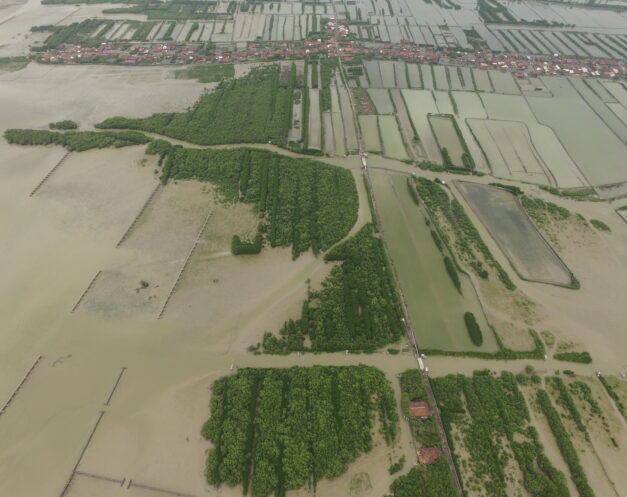
Reaching scale for coastal resilience
The initiative “Building with Nature Indonesia” aims to build stable coastlines with reduced erosion risk through a unique integration of mangrove restoration, small scale hard-engineering and sustainable land use. In doing so we enhance coastal security for 70.000 vulnerable people by avoiding further coastal flooding and erosion in Central Java and provide them with a long term perspective for sustainable economic development.

Building with Nature approach
Building with Nature is a comprehensive engineering approach that seeks to enhance the use of natural ecological processes to achieve efficient and sustainable hydraulic infrastructural designs. It strives for a flexible integration of land in water and water in land using interactions and materials present in nature. EcoShape members, including Wetlands International develop Building with Nature pilots, and share their concepts, knowledge and guidelines widely to stimulate replication and upscaling.
Building with Nature is now being used in the Netherlands on a large scale for managing its extensive coastal and river works. Wetlands International managed the first large-scale international pilot project in Demak in Indonesia.
Baseline situation Demak region, Central Java
30 Million people suffer from coastal flooding and erosion hazards in Northern Java, affecting 3000 villages. The five-year programme (2015-2020) focuses on the shoreline in Demak where sea level rise is projected to cause flooding 6km inland by 2100, inundating 14,700 hectares affecting over 70,000 people and the loss of 6000 hectares of aquaculture ponds.
The problems largely result from the removal of mangrove belts for aquaculture development, unsustainable coastal infrastructure, and groundwater extraction. In some places more than 3 km of land have already been taken by the sea and entire villages have been swallowed. Many people experience a major loss in income, reaching up to 60-80% in some villages. Also the agri- and aquaculture sectors, key economic engines in Indonesia, suffer multi-billion losses.
Business as Usual Scenario
The Business as Usual scenario in 2030 shows a fully flooded area with evacuated villages and land loss due to unsustainable groundwater extraction, mangrove loss and expected sea level rise, affecting over 70,000 people and 6000 hectares of aquaculture ponds. In the long run 30 million people may be affected by coastal erosion.
Dream Scenario
Our dream is to build a stable restored mangrove coastline that reduces erosion, can adapt to sea level rise and enables inclusive economic growth, so that communities in Demak are safe and can prosper. We do this through an inspiring Building with Nature pilot in which we trigger a paradigm shift towards water infrastructure solutions that align the interest of economic development with care for the environment.

Technical measures
Technical measures include the construction of permeable dams made of brushwood that capture sediment and help to establish a healthy sediment balance. Once the near shore bed level has sufficiently risen, mangroves will regenerate naturally developing a natural water defense protecting the hinterland against flooding and further erosion.
Socio-economic measures
By putting in place a model for sustainable aquaculture we address the root causes to the erosion problems. The project introduced a model for sustainable aquaculture that provides space for mangrove restoration, for example by giving up unproductive coastal ponds or part of riverine ponds to mangroves. In return for letting mangroves regenerate, shrimp farmers have been trained in sustainable techniques that have increased their shrimp production. As such we enable vulnerable communities and economic sectors to prosper, to be more self-reliant and to increase their hazard resilience. The measures will be controlled using community bylaws and rooted in community development plans and government master planning for sustainable development.
Video 5 years of Building with Nature in Indonesia
Knowledge and upscaling
The partners aim for replication and scaling up of the Building with Mangroves approach to other rural and urban areas in Indonesia and other vulnerable muddy coastlines in the world, including through capacity building, knowledge exchange and embedding in policies and planning.
Wetlands International is working to scale up Building with Nature in Asia in collaboration with the Indonesian Ministry of Marine Affairs and Fisheries, EcoShape and One Architecture, convened in Indonesia, Philippines, India, Malaysia and China, and other countries over time. Watch the video.
Public-private partnerships for landscape scale recovery
The initiative is the leading international case of the “Building with Nature Innovation program” and is strongly supported by the Indonesian government and local communities. The Building with Nature public-private partnership aims to promote sustainable coastal engineering approaches that make use of the natural protection provided by ecosystems like mangroves, and salt marsh habitats. It represents the transition of traditional infrastructure designs that typically fight against nature, towards solutions that work with and alongside nature, which are often more cost-effective, while bringing more prosperity to the local economy such as through enhanced fisheries and carbon storage.
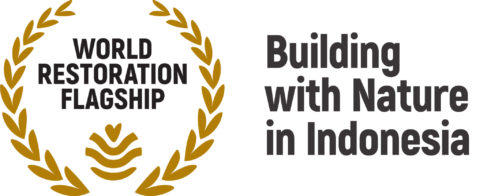
Awards
- Vernufteling award, 2016: a Dutch annual award for innovative engineering solutions in the Netherlands.
- Flood & Coast Excellence Award 2020: annual award that celebrates projects that set the standard for how to manage flood and coastal risk in the future in response to the climate and ecological emergency.
- World Flagship Award 2022 under the banner of the UN Decade on Ecosystem Restoration, which honours the most ambitious, promising and inspirational examples of large-scale ecosystem restoration, embodying the 10 Restoration Principles of the UN Decade on Ecosystem Restoration. See also the feature story on our World Flagship by UNEP.
Partners:
Building with Nature Indonesia is a programme by Wetlands International, Ecoshape, the Ministry of Marine Affairs and Fisheries (MMAF), Ministry of Public Work and Housing (PU), Witteveen + Bos, Deltares, TU Delft, Wageningen University & Research, UNESCO-IHE, Blue Forests, Kota Kita, Von Lieberman, the Diponegoro University, and local communities
Donors:
The initiative is financially supported by the Dutch Sustainable Water Fund on behalf of the Dutch Ministry of Foreign Affairs, The German Federal Ministry for the Environment, Nature Conservation, Nuclear Safety and Consumer Protection (BMUV) as part of the International Climate Initiative (IKI), and the Dutch Postcode Lottery, Waterloo Foundation, Otter Foundation, Top Consortia for Knowledge and Innovation, Partners for Resilience, and with contributions by all partners.
Downloads:
For detailed information on our interventions, take a look at the Series of 5 Technical Guidelines to support replication.
Website:
All scientific, technical and monitoring reports, newsletters, news and blogs about Building with Nature Indonesia can be found on the website: www.indonesia.buildingwithnature.nl
Documentary: Building with Nature Indonesia
Animation: restoring eroded coast Java by Building with Nature
Project partners are committed to drive the current Building with Nature innovation trajectory, by demonstrating the approach in a case study site in Demak. Successful implementation requires in-depth system understanding, extensive stakeholder engagement, and adaptive management on the basis of monitoring and evaluation. We stimulate and support upscaling of the approach by disseminating knowledge, lessons learned and implementation guidance. Stakeholders interested to replicate our approach are strongly recommended to adhere to this guidance and bear full responsibility for the success and sustainability of the approach.



